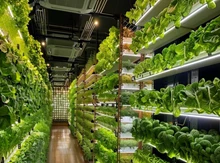
Introduction
Photosynthesis is the natural process by which plants use chlorophyll to absorb atmospheric carbon dioxide and convert it to sugar in the presence of sunlight.
Contrary to popular belief, plants can also do photosynthesis if the right spectrum of artificial light is provided. They can harness energy from any available light source, whether natural or artificial. The best example is Indoor Plants.
Let's delve into the fascinating world of photosynthesis and uncover how indoor plants thrive even without ample sunlight.
An Overview of Photosynthesis: Photosynthesis isn't solely dependent on sunlight. It's a multi-step process involving light absorption, electron transfer, ATP production, and carbon conversion.
Navigating the Process
-
Light Absorption: Plants absorb light through chlorophylls, initiating the conversion of light into energy and the removal of electrons from water molecules.
-
Transfer of Electrons: Electrons are transported throughout the plant, creating a charge that drives ATP production and facilitates essential biochemical reactions.
-
ATP Production: Converted electrons yield ATP molecules, which power various cellular functions necessary for plant growth and development.
-
Carbon Conversion: In the final stage, electrons and molecules from earlier steps produce nutrients vital for the plant's sustenance.
Optimal Lighting Conditions for Indoor Plants
The Importance of Light: Light is essential for the survival of all plants, including indoor ones. Without light, chlorophyll production is inhibited, leading to plant deterioration and eventual death.
Effects of Insufficient Light: Plants deprived of light exhibit visible signs of distress, such as discoloration (turning white or yellow) and elongated stems as they stretch towards a light source in a process called etiolation.
Activating Photosynthesis with Minimal Light: Remarkably, even brief exposure to light can kickstart photosynthesis in plants. While light is the primary catalyst for photosynthesis, plants also require carbon dioxide and water for the process to occur optimally.
Understanding Light Requirements: The amount of light needed for indoor plants varies depending on the species. Some plants thrive in shaded conditions and can photosynthesize with as little as 2-4 hours of light per day.
Strategic Placement: Placing indoor plants near a light source rather than directly under it ensures that they receive adequate light for photosynthesis. As long as light rays reach the plant's exterior, the process can be activated effectively.
Adapting to Low-Light Environments
Sunlight vs. Artificial Light: While sunlight provides a full spectrum of light, indoor plants can survive with minimal light spectrums. Red light promotes budding, while blue light fosters growth.
Unique Adaptations of Indoor Plants: Indoor plants have evolved mechanisms to thrive in low-light environments. They can efficiently photosynthesize even with limited light intensity and duration.
Factors Affecting Indoor Plant Survival: Various factors contribute to indoor plants' ability to photosynthesize without sunlight, including their genetic makeup, intensity, and duration of available light.
Ensuring Indoor Plant Health: By understanding the nature of indoor plant photosynthesis, growers can optimize light conditions to support plant growth and vitality. Regular monitoring and strategic placement near light sources are essential for maintaining healthy indoor plants. Indoor plants possess remarkable adaptability, capable of thriving in environments with minimal sunlight through efficient photosynthesis mechanisms. By providing the right lighting conditions, you can support the growth and well-being of your indoor green companions.










